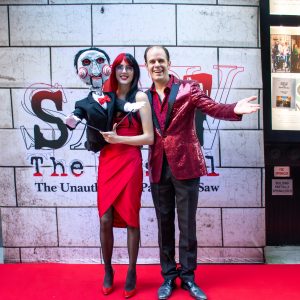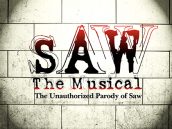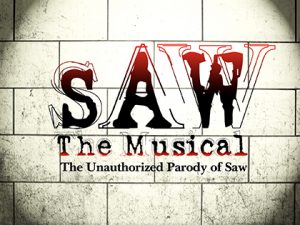
Creator Cooper Jordan and writer Zoe Ann Jordan of SAW: THE MUSICAL | ©2024 Saw the Musical parody LLC
Pop quiz. What’s the most unlikely movie to ever get turned into a stage musical? If you somehow guessed SAW, you may be right.
As subject matter goes, the 2004 horror film, which has launched a franchise (SAW XI is due out later this year) as well as the careers of director James Wan and his co-writer Leigh Whannell, doesn’t seem a likely candidate for upbeat musical numbers. It has two men – Adam, played by writer Whannell, and Dr. Lawrence Gordon, played by Cary Elwes – chained up at opposite ends of an industrial bathroom, where the only means of escape seems to be to saw off a limb. There are flashbacks, there’s a lot of gore, and plenty of other elements that would seem impossible for a three-person cast and a small budget, to say nothing of the deadly serious mood.
But SAW: THE MUSICAL exists. After an out-of-town production in Philadelphia, it transferred to off-Broadway, where it is running through at least June of this year. Meanwhile, a second company is touring the country. After a Los Angeles run, it has now moved to San Diego, with more stops planned in Portland, Oregon; Boise, Idaho; Salt Lake City, Utah; Greeley, Colorado and more (for details, go to the website for sawthemusical).
Created by producer Cooper Jordan, with a script by his sister Zoe Ann Jordan, the “unauthorized parody” has music and lyrics by Patrick Spencer & Anthony de Angelis, and is directed by Stephanie Rosenberg.
During the last week of the Los Angeles run in Hollywood’s Hudson Theatre, while assistant stage manager Hannah Cairo mops fake blood off the stage the Jordans sit down for a conversation, frequently overlapping and completing each other’s sentences. As they share a surname, their first names are used here for clarity.
For starters, how did SAW: THE MUSICAL come about? “We’re massive SAW fans, obviously,” Cooper states.
Zoe elaborates, “He was watching SAW movies at a reasonable age, when I was crawling under the table to watch.”
Their mother didn’t know about their viewing fare at the time, Zoe laughs. “Now, I’m like, ‘Mom, isn’t it worth it? I have a successful show that came out of that.’ She’s like, ‘It wasn’t worth it. I would have still never let you watch that if I knew.’”
Cooper relates, “I moved to New York to be an actor, and I was an actor, and I am an actor, but I fell into producing at nineteen.” An early role was Buffalo Bill from SILENCE OF THE LAMBS in a show called BLOOD MANOR. “I was written up in the [NEW YORK] TIMES for it.”
“He was a fantastic Buffalo Bill,” Zoe notes.
Within the next few years, Cooper saw SILENCE OF THE LAMBS: THE MUSICAL. “It inspired me when I saw it, obviously. It set so many precedents. But it also was going along with what theatrical parody law is, which is basically to go along with what is done in the piece, and to hyperbolize it to the hundred-and-tenth degree.”
Since the SAW films are owned by Lionsgate, and SAW: THE MUSICAL is not a Lionsgate production, there have been back-and-forth discussions with the film company. The upshot has been that Lionsgate has okayed the version that their representatives saw opening night in Philadelphia; any subsequent changes would have to receive new permissions.
“You can’t digress from the main beats of the plot,” Zoe explains, “without having it challenged legally. But with parodies, you do have to have a transformative element. You can’t just make fun of [the original] and let that stand.”
This brings us to another aspect of SAW: THE MUSICAL. While it’s doubtful Wan and Whannell were contemplating this, it’s possible to see a gay subtext in SAW. In SAW: THE MUSICAL, there’s nothing “sub” about it. “That wasn’t only the reason why I wanted the romance in the show,” Zoe explains, “but it was certainly the transformative element, I think, that elevated it to that level that couldn’t be challenged, and could draw people in.”
She adds that the SILENCE OF THE LAMBS-derived television series HANNIBAL, which has both queer text and subtext, is “my favorite TV show of all time. It was a huge inspiration for me for this musical. I’m such an admirer of [HANNIBAL creator Bryan Fuller’s] work. I think what he did with HANNIBAL and what he did with the SILENCE OF THE LAMBS legacy was so important to queer horror and queer representation. He created a transformative element to the adaptation, which is what I was hoping to do with this, and I think has reached a lot of people in the same way. I’m way more honored about that than I can say.”
Cooper relates, “[Zoe] had pointed out to me, as we created it, that queerness is not new to horror. It is so much a part of the horror world.”
Zoe picks up the thread. “It’s been maybe the genre where queer people have felt more represented than anywhere else, because of the Hayes Code, and because of how queers were treated in the early days of cinema, when they were only able to be depicted as villains and as monsters. That sort of transformed itself into the representation now that they feel drawn to, because that has been the representation that they’ve had for so many years, and it’s a way that they’ve reclaimed it, is that there are all these queer subtexts and themes in horror films.”
“So, this was, ‘Oh, good, so, we’re not completely reinventing the wheel with what we’re doing’,” says Cooper. “It’s worked. I never had any intention of this being gay. I just wanted to do a SAW musical.”
Previously, Cooper had produced DEXTER: THE MUSICAL. Unfortunately, a combination of a large cast and a lack of air conditioning in the theatre during summer created insurmountable obstacles for the production’s longevity.
Still, Zoe points out, “It taught you what to do and what not to do in theatre parody and horror parody.”
“I learned a lot,” Cooper agrees. “And it was a beautiful piece that we made, but life goes on.”
Cooper already knew he wanted to do SAW: THE MUSICAL. The opportunity came “in 2022 with the pandemic. Theatres were still suffering. [The Adrienne Theatre] in Philadelphia that I’d worked with that was begging me to do something, because there was nothing happening in there. And so, they gave me October [as a slot for a production], and I called my sister. ‘Zoe, can you look at this script, can you finish this for me?’ And she said, ‘Yes, of course I will.’ We had, obviously, a very short amount of time to get it up, because it was a deadline with the theatre.”
Zoe recalls with a laugh, “I basically reworked it and wrote the entire thing in two weeks.”
Songwriters Spencer and de Angelis were found via Theater Resources Unlimited in New York, which Cooper describes as “speed-dating” for writers and producers. “It’s a huge event. These two were doing a horror Christmas tree musical. I listened to some of their music – it’s extremely funny, and we were very excited to get to work with them, and they did an amazing job.”
Director Rosenberg has helmed all of the productions, from the original through the touring companies. “She’s also a co-producer,” Cooper explains. “I begged her to do it. I’ve known her for many years. She’s a huge Cary Elwes fan, so as soon as I said this was SAW I, she was in, a hundred and fifty percent.”
When Cooper first conceived of SAW: THE MUSICAL, he envisioned it with a cast of two. “It was a producer’s dream – the bathroom, two guys, single set.”
Zoe reminded him that they needed Amanda, played in the franchise by Shawnee Smith, “the only person who would survive the Jigsaw murders.” There’s also a body on the floor (SAW: THE MUSICAL makes it clear early on that this isn’t really a corpse), who proves to be crucial.
Cooper reminds Zoe, “Your first question was, ‘Brother, who’s on the floor?’ And I was like, ‘Oh …’ And then you were like, ‘And Brother, Amanda.’ And I was like, ‘Oh! Fine, three’,” he laughs.
At this juncture, neither sibling had seen the original SAW in a while. “Our favorites were SAW V and VI,” Cooper reveals. “We watch those all the time.”
When Zoe rewatched SAW I, she felt, “‘There is something much deeper here than just what I remember loving, and what I think the world has expected of this movie. I think there is a fan base that hasn’t been spoken to by the franchise. I think we could offer a place for them to be heard and to offer them what they don’t get to have every other day.’”
“That’s right,” Cooper affirms. “She comes back and says, ‘Cooper, they’re gay.’ I’m like, ‘No, Zoe, they can’t be gay, what are you talking about?’ She says, ‘No, Cooper, rewatch it. They’re in love.’ I’m like, ‘No, Zoe, come on.’ And I rewatched it the next day, and I’m like, ‘Oh, my God.’ There were so many moments that we [initially] missed, because we were kids, it was 2004, and they’re not playing into it, and I don’t think that was ever the intention, but it was something beautiful that was created in 2004, and the chemistry that those two had, that inspired so many fans to ‘ship’ them. It’s huge. So, we realized we had fallen into this thing that is already there.”
On the rewatch, Zoe keyed in on the subplot involving Lawrence trying to cheat on his wife with another woman, not following through, and generally suffering an inability to figure out what’s making him so unhappy. “I think that could be ascribed to a sexuality crisis in the early 2000s.”
Even more important, Zoe emphasizes, “The emotional climax of the film is the two men holding each other, and having that human physical connection be the main part of the reason why they’re there, and why they are learning how to cherish life. I think human connection – the way that we all cherish it, we have to have someone there to help us and to save us and to learn how to appreciate things, rather than just wallow in our own sadness in our brains. I think it’s begging to be romantic. I think romance comes from a place of needing connection and wanting to cherish life, but not alone.”
“I think that’s a beautiful idea,” Cooper adds. “What’s more relevant than human connection?”
Simultaneously, SAW: THE MUSICAL is incredibly silly. Various influences include LITTLE SHOP OF HORRORS and the puppet musical AVENUE Q.
“The puppet [in SAW: THE MUSICAL] was definitely inspired by AVENUE Q,” Cooper acknowledges. “I said was, ‘Zoe, I want the singing puppet. That’s basically all I want.’ Of course, I wanted more than that, but we did get that,” he laughs.
And SAW: THE MUSICAL wouldn’t be SAW without the gore. The leg that has to be sawed through is made of gelatin, personally prepared by Zoe. “We have a leg that I actually cook for every show, that [the actor playing Lawrence] can saw through it. It’s a very finite prop with many steps.”
The foot has gone through an evolution, Zoe relates. “Originally – because our foot is the ultimate gore – our foot prop in Philadelphia was a Pringle’s can …”
“It was a Lay’s Stacks can, actually,” Cooper interjects.
After this potato chip correction, Zoe continues, “We had cut it open and foamed and put a pant leg over. It actually worked pretty well. He could slide his foot in there. It was pretty snug. We had a fake foot Velcroed to some little red fabric, and he was able to just fake saw it off.”
Gelatin wasn’t yet in the budget, but, Zoe says, “It did include the blood packs that we used. We had tiny ones they’d pop behind their feet, that strangely enough worked better in some ways than our New York one. We commissioned a magic box for New York, which was very pricey, but he would have been able to put his leg inside the box and then fake-saw it off, the fake leg, but it came with the wrong dimensions, half-broken …”
“We spent two weeks fixing it,” Cooper laments.
“It never really worked,” Zoe agrees, “so we invested in a fake silicone rubber calf and foot that I basically just peeled over the rubber foot and, again, it was a fake sawing situation. But the blood packs and the actors really elevate it. With the black pant leg and the shirt tied around it, it’s harder to see the issues with that. But I said, ‘I think if we’re going to up the budget on one thing here, we’re going to up it on the foot.’
“I contacted everyone under the sun that’s ever done gore in theatre. The only person that picked up was Steve Tolin from Tolin FX, who did the effects for EVIL DEAD: THE MUSICAL. I said, He told us that they make a gelatin wrist for when Ash slices his chainsaw through the hand. We sent him video of our New York foot, and we were like, ‘Please save us, please save our lives.’ He designed it. He’s been great. Our foot looks fantastic every time we saw through it. The actors are enjoying the hell out of it.”
Zoe believes that Tolin cast his own foot and calf for the mold. “It’s a big casting that I pour gelatin into that he probably did around his own calf, too. The foot is a really hard rubber foot. There’s a foam piece knee, and then I cast what’s here under the knee, so, [the actor] can saw through that. Since his real leg is on the other side of the box, he has a sock that has fake gore coming out of it. He slides that on before he does all the other stuff, so he’s ready to come crawling across the stage without a foot.”
Unlike film, when something goes wrong on stage, nobody can just call “Cut.” Zoe remembers that at one recent performance, “I had the nightmare of my life, when I realized that I hadn’t set the blood sock inside the box. So, I had three minutes to figure out how to get rid of this actor’s foot onstage. So, I was backstage, ripping apart black fabric with [gaffer’s tape]. I was like, ‘Just tape it to your foot.’ We found [the sock] right before the scene started. I think we’ve gotten into a rhythm with the gore.”
A few O.G. SAW personnel have come to see the musical, including Kevin Greutert, who directed SAW VI, SAW VII (SAW 3D), SAW X, and the upcoming SAW XI, as well as editing SAW I through V.
“He basically gave us his seal of approval in a tweet,” says Zoe, “which meant the world to us.”
“He gave us an endorsement that night, which was a blessing and a half,” Cooper adds.
Also, Zoe recalls, “I had a great long conversation with David Armstrong, the d.p. for the first movie, who worked on many of the other ones. And I think their support, even though it was such a small group of people there, was so meaningful.”
One of the Spierig brothers, who directed JIGSAW, has also visited the L.A. production. “And,” Cooper notes, “an actor we love in SAW V, Carlo Rota, came and was so gracious. He brought his son, who’s more of a fan of SAW than we are,” he laughs.
The Jordan siblings are likewise delighted by reactions from members of the general public. “I’m thrilled by it,” Zoe affirms. “I’m so happy that my goal in this has been achieved in that I wanted them to be heard and to have something to love that is this explicitly queer.”
Cooper concurs. “I continue on a daily basis to be amazed at how many people come through these doors that are just unheard queer people in America, and SAW: THE MUSICAL is a voice for them.”
“We’re excited to bring it to Idaho and to Minnesota, and all these places where they don’t get these types of musicals or productions,” says Zoe. “I would just love to reiterate, I loved SAW so much, and I love its community, and I love every queer person who has come and expressed how much this has meant to them, because it means the same to me. And I hope we can continue doing that everywhere. I want this to go on as long as it can, to do that in every place in the United States.”
Cooper that they can’t wait to bring SAW: THE MUSICAL to new states and cities. “We can’t wait. There are so many different types of people coming to the show together, sharing their experience together.”
Follow us on Twitter at ASSIGNMENT X
Like us on Facebook at ASSIGNMENT X
Article Source: Assignment X
Article: Exclusive Interview: Creator Cooper Jordan and writer Zoe Ann Jordan on the new musical stage parody SAW: THE MUSICAL
Related Posts:












